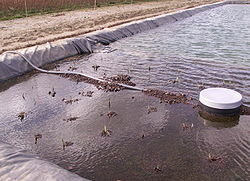A treatment pond treats water fouled by anaerobic bacteria. It is used mainly by tree nurseries, dairy farms and other agricultural companies near horse or cattle sheds or barns. The pond treats polluted stormwater and animal wastewater so that it may be returned to the environment as fertilizer and irrigation water.
Uses of treatment ponds
A treatment pond may be used in combination with a rainwater reservoir to form an ecological, self-purifying irrigation reservoir or swimming pond.[1][2] A pond may dispose or treat industrial liquid wastes. An example is the Martinez, California treatment ponds developed by IT Corporation. Small-scale treatment can be done in small ponds if the effluent is given time to break into harmless nutrients. However, smaller ponds may need to be divided in much the same manner as septic tanks.
Set-up
Constructed wetlands
Urban areas

Three reedbed setups are in use. Each are being used in commercial systems (usually together with septic tanks).[3] They are:
- Surface flow (SF) reedbeds
- Subsurface Flow (SSF) reedbeds
- Vertical Flow (VF) reedbeds
All three are placed in a closed basin with a substrate. For most commercial purposes (e.g., agriculture) ponds are lined with rubber to ensure being watertight (essential in urban areas). The substrate can be gravel, sand or lavastone.
Design Characteristics

Surface flow reedbeds use a horizontal flow of waste water between plant roots. They are no longer much used, as they need considerable space (A person requires 20 m2 to purify the water they use.) They have increased smell and poorer purification in winter.[4]
With subsurface flow reedbeds, the flow of waste water is between plant roots, but not at the water surface. This is more efficient, less smelly and less sensitive to winter conditions. The soil to purify water is 5–10 m2 per person. Intakes, which can clog easily, are a potential problem.[4]
Vertical flow reedbeds are similar to subsurface flow reedbeds (subsurface wastewater flow is present here as well). Therefore they have similar efficiency and winter hardiness. Wastewater flow is somewhat different though, as it is vertical. The wastewater is divided at the bottom with the assistance of a pump. Other than the two previous systems, this system almost makes exclusive use of fine sand to increase bacteria counts. Intake of oxygen into the water is better. Pumping is done in pulses to reduce obstructions with the intakes. Only 3 m2 is needed to purify the water for one person.[4]
Organisms
Usually, common reed or Phragmites australis are used in treatment ponds (e.g., in greywater treatment systems to purify wastewater). In self-purifying water reservoirs(used to purify rainwater), other plants are used as well. These reservoirs need to be filled with 1/4 lavastones and water-purifying plants.[5]
Treatment ponds use a wide variety of plants, depending on the local climate and other conditions. Plants are generally chosen which are indigenous, for environmental reasons and optimum performance. In addition to water purifying (de-nutrifying) plants, plants that supply oxygen, and shade are added in ecological water catchments, ponds. This allows a complete ecosystem. Local bacteria and non-predatory fish may be added to eliminate pests. The bacteria are usually grown by submerging straw in water and allowing bacteria from the surrounding air to form on it. Plants are divided in four water depth-zones:
- A water depth from 0–20 cm. Iris pseudacorus, Sparganium erectum may be placed here (temperate climates).
- A water depth from 40–60 cm. Stratiotes aloides, Hydrocharis morsus-ranae may be placed here (temperate climates).
- A water depth from 60–120 cm. Nymphea alba, may be placed here (temperate climates).
- A submerged water depth. Myriophyllum spicatum may be placed here (temperate climates).
Three non-predatory fish (surface, bottom and ground-swimmers) are chosen. This ensures the fish 'get along'. Examples for temperate climates are:
- Surface swimming fish: Leuciscus leuciscus, Leuciscus idus, and Scardinius erythrophthalmus
- Middle-swimmers: Rutilus rutilus
- Bottom-swimming fish: Tinca tinca
The plants are usually grown on coconut fibre.[6] At the time of implantation to water-purifying ponds, de-nutrified soil is used to prevent growth of algae and other unwanted organisms
Finishing
These systems, for example, aerate the water after the final reedbed using cascades such as flowforms before holding the water in a shallow pond.[7] Primary treatments such as septic tanks, and pumps such as grinder pumps may be added.[8]
Rooftop treatment ponds
Rooftop water purifying ponds are being used on rooftops. These green roofs can be built from a simple substrate (as is being done in Dongtan)[9] or with plant-based ponds (as is being done by WaterWorks UK Grow System).[10] Waterzuiveren.be[11] Plants used include calamus, Menyanthes trifoliata, Mentha aquatica, ...[12]
See also
External links
References
Template:Cleanup-link rot Template:Reflist
- ↑ Ecologic water basins used for agriculture/irrigation
- ↑ reservoirs made self-purifying through addition of treatment pond
- ↑ reedbed descriptions
- ↑ 4.0 4.1 4.2 reedbed secriptions
- ↑ Overview of lavafilters
- ↑ Coconut growing medium used for water purifying plants
- ↑ [1] reedbed and flowform cascade polishing, Sheepdrove Organic Farm, England
- ↑ Pictures of hybrid reedbed systems
- ↑ Dongtan green roofs filter water
- ↑ WWUK rooftop water purification with plants
- ↑ Waterzuiveren.be building water-purifying roofponds
- ↑ Description of plants used in water-purifying rooftop ponds